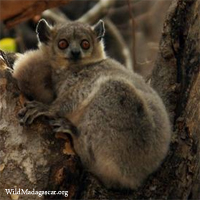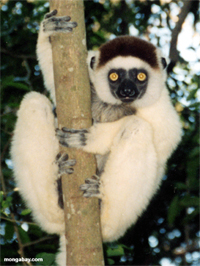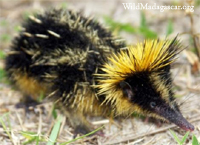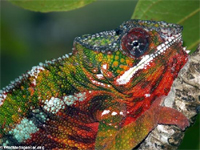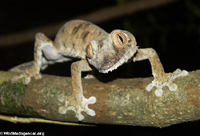1 million ha now protected in Madagascar, island home of lemurs
WCS news release
January 6, 2006
NEW YORK, NY (January 6, 2006)—The government of Madagascar has scored a significant victory for conservation by bringing one million hectares (more than 3,800 square miles) of wild landscapes and seascapes under protection to conserve the island nation’s unique fauna and flora, according to the Wildlife Conservation Society (WCS). The newly established Makira Protected Area—one of the country’s five new protected areas—now forms along with existing Masoala National Park the largest contiguous tract of rain forest under protection on the island, home to lemurs, serpent eagles, chameleons, geckos, and other wildlife found nowhere else on Earth. An estimated one percent of the world’s biodiversity is found in the forests of Makira and Masoala.
Most importantly, the new protected areas represent an important benchmark in an overall plan for conservation and sustainable development for Madagascar, first unveiled by President Marc Ravalomanana at the World Parks Congress in Durban, South Africa in 2003. In what is now known as the “Durban Vision,” Ravalomanana committed his country to increasing the total amount of wild land under protection to 10 percent of the country’s total area, from 1.7 million hectares to 6 million hectares in a five-year period. A new System of Protected Areas has been launched with the creation the initial one million hectares (3,859 square miles) of protected areas.
“Our work in Madagascar is intended to support the Malagasy government and people as they strive toward their ambitious goals for conservation and development. This is a great moment to celebrate as we mobilize for the important work ahead,” said Dr. Steven E. Sanderson, WCS President and CEO.
The success in reaching this milestone is a reflection of numerous collaborations between government and non-governments organizations and donors in Madagascar. As General Charles Sylvain Rabotoarison, the Malagasy Minister of Environment, Water and Forests signed the decree to officially protect one million hectares, he thanked the collaborative effort of national and international NGOs working in the field with government partners and local communities to realize the impressive conservation goals.
|
|
WCS has a long history of conservation work in Madagascar, beginning with survey work that led to the establishment of Masoala National Park in northeastern corner of the island in 1996. WCS continues to co-manage the park along with the National Parks Service of Madagascar (ANGAP) and will manage the new Makira Protected Area in partnership with the Ministry of Environment, Water and Forests.
The newly established Makira Protected Area—adds 371,000 additional hectares (1,432 square miles) to the existing 230,000 hectares (888 square miles) of protected forest in Masoala National Park, both of which now contain more than 10 percent of the Madagascar’s remaining humid forests and approximately 50 percent of the island’s biodiversity. Conservation International provided key support and funding for the establishment of the Makira Protected Area.
“Protecting the forests is critical to not only wildlife, but also the people who rely on the forests for their livelihoods and resources,” said Dr. Helen Crowley, Director of WCS’ Madagascar Program. “The majority of Madagascar’s forests have been cleared, with only 15 percent of the land surface remaining forested. Saving what’s left has become critical for all of the island’s inhabitants, humans and animals alike.”
One of the key aims of the new Protected Areas System of Madagascar is to involve local communities in conservation and management, and empower them as stewards of their natural resources. For instance, the forest surrounding Makira will be managed and conserved by the local communities for their own livelihoods.
The forests of Masoala and Makira also form the watershed for the magnificent Antongil Bay, where WCS is also working to conserve coastal and marine environments and protect species such humpback whales and dugongs. The work of the WCS program extends to several sites in Madagascar as well. Over the last five years, WCS has championed the creation of Sahamalaza-Iles Radama Marine Biosphere Reserve as a new protected area. Soon to become a national park, the marine reserve contains a mosaic of important coral, mangrove, and forest ecosystems.
WCS is currently working to help develop and promote ecotourism opportunities around the island in various protected areas with the aim of generating direct benefits of conservation for local communities and the national economy. WCS is committed to and providing continued support for Madagascar’s government institutions on setting national and regional conservation priorities.
Tourism in Madagascar; Visiting the World’s Most Unusual Island
Madagascar is a place like no other. Separated from mainland Africa for some 160 millions years, 80% of its native flora and fauna are unique to the island. Madagascar is home to such evolutionary oddities as the fossa, a carnivorous mammal that looks like a cross between a puma and a dog but is closely related to the mongoose; the indri, a cat-sized lemur that leaps from tree to tree with ease and sings eery, whale-like songs; the sifaka, a lemur, that swears rudely but dances like a ballet performer; and the streaked tenrec, a spiny yellow and black insectivore that resembles a miniature hedgehog and makes grinding-chirping noises when threatened. It has baobab trees, which look like they’ve been planted upside down; the rosy periwinkle, a delicate flower used to cure pediatric leukemia and Hogkin’s disease; and an entire desert ecosystem consisting of just spiny plants. To top it off, the residents of Madagascar, the Malagasy, have equally unusual origins as reflected by their mixed traditions and cultural practices. The Malagasy speak a language native to Borneo (across the Indian Ocean in Indonesia) and observe some distinctly southeast Asian religious practices; use Arabic-rooted words for months and days of the week; and greatly treasure African Zebu cattle. Given Madagascar’s proximity to the African coast who would have expected such a background? Who would have thought that 2000 years ago the island’s first settlers had origins in Indonesia?
This is a press release from WCS.
